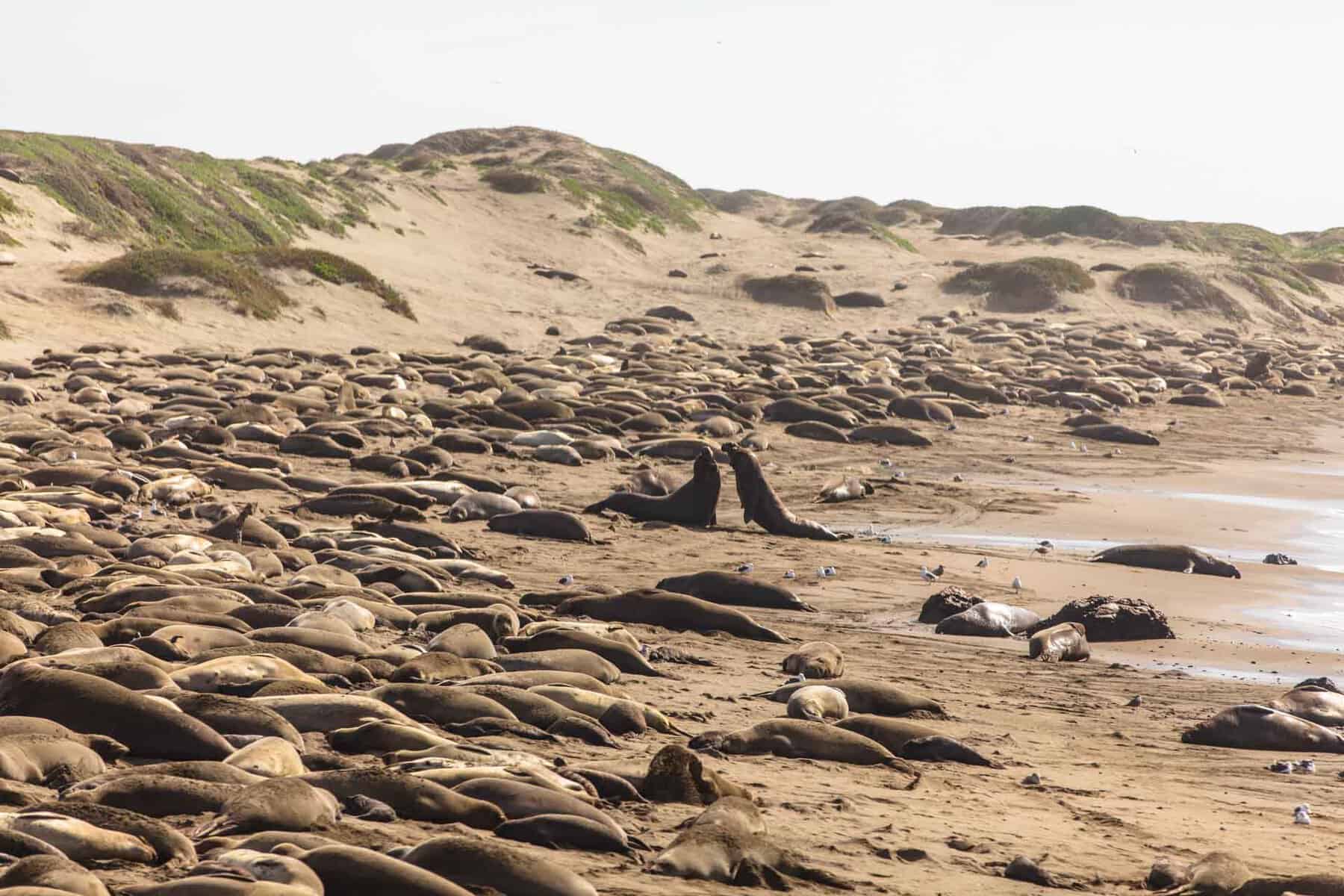Above the coastline of the Pacific Ocean between San Simeon and Ragged Point, the Piedras Blancas Light Station stands as a monument to maritime days gone by. The lighthouse, built in 1875 and still in operation today, offers 2-hour tours of its interior and grounds, year-round. Access to the light station grounds is by guided tour only.
Piedras Blancas Light Station History
Centuries ago, Native Americans made Point Piedras Blancas their home, using resources from both land and sea to thrive here. Later, mariners named it “Piedras Blancas” after the white rocks they used to navigate this bit of shoreline. The Piedras Blancas lighthouse was built to protect sea goers from craggy cliffs and guide their travel along the Pacific Coast. The Fresnel lens, made in France by Henri Lapaute in 1872, flashed every 15 seconds. (Due to earthquake damage in 1949, the lens now resides on loan at the Lions Club in nearby Cambria.) Today, the Bureau of Land Management works in tandem with the Piedras Blancas Light Station Association to maintain the lighthouse.
Piedras Blancas stands along one of California’s few designated scenic byways, Highway 1. It also lies within the Piedras Blancas State Marine Reserve (SMR) and comprises part of the Monterey Bay National Marine Sanctuary (MBNMS). This sanctuary boasts kelp forests, quiet beaches, elephant seal habitats, and tidepools, all protected through the California Marine Life Protection Act of 1999 (MLPA). As a result, visitors to the Piedras Blancas lighthouse have access to plenty of wildlife viewing and scenic, untouched vistas.
The lighthouse is also federally recognized as part of the California Coastal National Monument and Piedras Blancas Light Station Outstanding Natural Area. Furthermore, the Piedras Blancas Light Station itself is listed on the National Register of Historic Places.

Piedras Blancas Light Station Tours
Tours of the Piedras Blancas Light Station take place year-round, every Tuesday, Thursday and Saturday morning. During the summer season, additional tours occur Monday and Friday mornings. Tours are cancelled during inclement weather, and the light station is closed on all federal holidays.
To sign up for a tour, purchase tickets in advance online, or on the day of your preferred tour. Groups of 10 or more must purchase tickets in advance and notify the Piedras Blancas Light Station Association to ensure adequate guides. Your ticket purchase help preserve and conserve the Piedras Blancas Light Station. Know that your dollars are put to good use with this Stewardship Travel for Good attraction.
Visitors meet at the Piedras Blancas Motel, just north of the lighthouse (not at the gate to the lighthouse itself) and follow guides to the lighthouse. The tour lasts two hours and includes 1/2 mile of easy walking. Note that while guides tour the inside of the lighthouse, walking up the tower is strictly forbidden for safety. Some binoculars are available for viewing the abundant wildlife on the preserve, but visitors would do well to bring their own. Strollers and wheelchairs are also available upon request. Also, take note that smoking on light station grounds and pets are both prohibited.
All tour guides are extremely knowledgeable, including academics, history buffs, naturalists and maritime enthusiasts. These experts lead visitors across the property, discussing the cultural and natural history of Piedras Blancas, telling stories, taking questions, and identifying wildlife.
Tours of the Piedras Blancas Light Station occur year-round, with temperatures ranging from 48°F to 67°F, depending on the time of year. The warmest, driest, and clearest months for touring the lighthouse are September and October. But generally, conditions are cool and windy; layered clothing is a must. Wear comfortable walking shoes, as well as a hat for sun protection. Neither food nor drink is offered on the tour, but water bottles are allowed

Piedras Blancas Elephant Seal Rookery and Marine Life
The Piedras Blancas State Marine Reserve (SMR) is a no-take zone located between Arroyo De La Cruz at Point Sierra Nevada and Arroyo Laguna, near San Simeon. It is adjacent to the Piedras Blancas State Marine Conservation Area (MCA) centered around Point Piedras Blancas.
The Marine Life Protection Act of 1999 (MLPA) required the California Department of Fish and Wildlife to redesign its system of marine protected areas (MPAs) to increase protection of the state’s marine life, habitats, and ecosystems.
At Piedras Blancas, observe migrating whales, seabirds, sea otters, dolphins, and tide pool marine life – all from the lighthouse grounds. In addition, Piedras Blancas Point boasts one of the most robust Northern Elephant Seal Rookeries in the world, with 25,000 seals migrating there annually. The Northern Elephant seal is the second-largest seal in the world, and the largest in the northern hemisphere. Come witness these majestic creatures as they mate, spar, birth and molt, just off Highway 1. The seals can be seen from a roped-off viewing area that shows their lives, up close and personal.

Fun Movie Fact
A midcentury horror film called The Monster of Piedras Blancas takes place at the historic Piedras Blancas Light Station. Produced in 1959, the film tells the story of a lighthouse keeper who tries to keep a sea monster from devouring his beautiful daughter ― and the local townfolk! Though it wasn’t filmed at Piedras Blancas (that happened on Point Sal, in Lompoc), shots of the Piedras Blancas lighthouse are shown throughout.
Near Piedras Blancas
There’s plenty more fun to be had near the Piedras Blancas Light Station. Take a tour of the lighthouse, then head to some of these other family-friendly attractions. And don’t miss the lighthouse’s original Fresnel lens, on loan from the Coast Guard at the Cambria Lions Club, 1000 Main Street in Cambria.
Hiking and Boucher Trail
North San Luis Obispo County offers some of the best hiking in California, with abundant coastal views and untouched scenery. Hit the Boucher Trail, which offers 3.8 out-and-back miles of easy walking from the main Elephant Seal vista past the Piedras Blancas lighthouse. The hike takes in spectacular views of the coastline and wildlife, through grasslands and wetlands, as well as coastal bluffs.
Ragged Point
For more stunning views of the winding Pacific coast, travel north to Ragged Point, the gateway to Big Sur. Grab an ice cream or coffee, and hang out on the Ragged Point Inn lawns or enjoy the “million dollar view.” Or, if you feel like a trek, take the steep Cliffside Trail down to a waterfall and black sand beach. Of course, if you’re hungry, dining at the Ragged Point Restaurant is a must, enclosed in glass with a 180-degree view of the ocean.
Hearst Castle
No trip along Highway 1 is complete without a tour of Hearst Castle. Witness the grandeur and opulence of newspaperman William Randolph Hearst’s hilltop estate, which hosted many celebrities and dignitaries of the early- to mid-20th century. Tours with expert guides take in most areas of the property, from the grand rooms and outbuildings to the gardens, kitchen and two epic swimming pools.

Stewardship travel for good
This historic light station has stood watch over the Estero Bay since 1875, and it maintains its position (and beam) thanks to the efforts of volunteers, the tours they lead through the property, and donations from visitors. Book a tour of the lighthouse year-round on Tuesday, Thursday or Saturday mornings, and enjoy learning about the maritime history and natural history of this landmark light station. More info can be found at the Piedras Blancas Light Station


